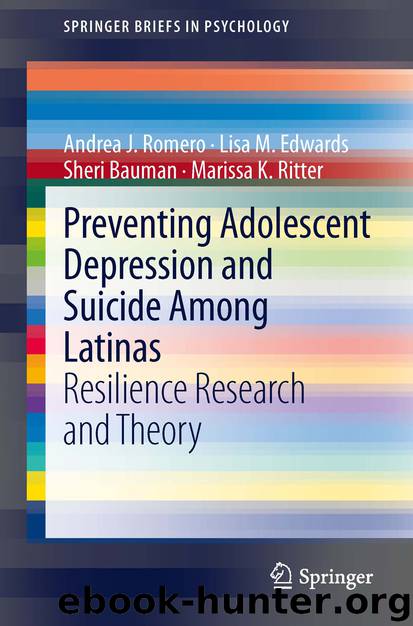Preventing Adolescent Depression and Suicide Among Latinas by Andrea J. Romero Lisa M. Edwards Sheri Bauman & Marissa K. Ritter

Author:Andrea J. Romero, Lisa M. Edwards, Sheri Bauman & Marissa K. Ritter
Language: eng
Format: epub
Publisher: Springer International Publishing, Cham
Family Stress and Conflicts
Many aspects of the family environment are relevant to the discussion of risk for suicide attempts in Latina adolescents. As noted previously, acculturation discrepancies between parents and daughters are frequently mentioned as a risk factor, but economic status may affect this dynamic. For example, several studies cited by Zayas et al. (2000) note that fewer suicide attempts are reported by middle class compared to lower class Latinas. They suggest that as parents’ income and education increase, their parenting style often becomes less authoritarian, which will diminish the level of intrafamilial conflict. In addition, as parents’ education and income increase, they may have more access, awareness, and familiarity with outside resource help. Interestingly, Guiao and Esparza (1995) found in their study of suicide in Mexican-American teens that family adaptability was not a significant predictor of suicidal behavior, but the level of family cohesion was highly significant and second only to depression in predictive power (see also Peña et al. 2011). In Chap. 3, we described the cultural values of familism that may make certain cultural norms of Latinos unique, such as daily family interaction and extended family member involvement in raising children. Zayas and colleagues’ (2000, 2005) ecodevelopmental models focus on the family as the most central factor in Latina adolescent mental well-being, in part because family conflict is perceived as very serious and troublesome in the context of Latino cultural values and norms of family closeness and unity. In the next section, we will focus on studies that describe what happens when some Latino families develop unhealthy patterns of interactions that may lead to depression and suicide among adolescent girls.
Family history for suicidal behaviors may also impact Latina teens’ mental health. In the Rew et al. (2001) study, Hispanic girls in grades 7–12 had the highest rates of all ethnic/gender groups for suicide attempt by family member and also for completed suicide by family member. They had the highest rates of suicide attempts by friends as well, but not for completed suicide by friends. Additionally, Latina girls are more likely than Latino boys or other ethnic groups to report family members have committed suicide, which may be a risk factor for their own depression or suicide attempt (Rew et al. 2001). Family conflict is often found to be the precipitant for suicidal behavior in adolescent Latinas (Gulbas et al. 2011). An interesting study categorized the types of family relationships found in a sample of Latina adolescents (122 of whom had attempted suicide and 110 who had not). From their extensive interviews with the adolescents and their mothers (and fathers when available), they described three patterns: reciprocal (in which everyone in the family contributes, and there is a strong sense of togetherness and respeto, which is respect from children to parents and also from parents to children); asymmetrical (relationships are one directional, with a member giving all to the family without receiving anything in return); and detached (lack of commitment to family, respeto is absent, authority expressed via physical abuse, or rules not enforced).
Download
This site does not store any files on its server. We only index and link to content provided by other sites. Please contact the content providers to delete copyright contents if any and email us, we'll remove relevant links or contents immediately.
Rewire Your Anxious Brain by Catherine M. Pittman(18553)
Talking to Strangers by Malcolm Gladwell(13222)
The Art of Thinking Clearly by Rolf Dobelli(10221)
Mindhunter: Inside the FBI's Elite Serial Crime Unit by John E. Douglas & Mark Olshaker(9201)
Becoming Supernatural by Dr. Joe Dispenza(8119)
Change Your Questions, Change Your Life by Marilee Adams(7635)
Nudge - Improving Decisions about Health, Wealth, and Happiness by Thaler Sunstein(7615)
The Road Less Traveled by M. Scott Peck(7522)
The Lost Art of Listening by Michael P. Nichols(7406)
Enlightenment Now: The Case for Reason, Science, Humanism, and Progress by Steven Pinker(7235)
Mastermind: How to Think Like Sherlock Holmes by Maria Konnikova(7227)
Win Bigly by Scott Adams(7094)
The Way of Zen by Alan W. Watts(6506)
Daring Greatly by Brene Brown(6445)
Big Magic: Creative Living Beyond Fear by Elizabeth Gilbert(5610)
Grit by Angela Duckworth(5523)
Ego Is the Enemy by Ryan Holiday(5294)
Men In Love by Nancy Friday(5155)
Altered Sensations by David Pantalony(5045)
